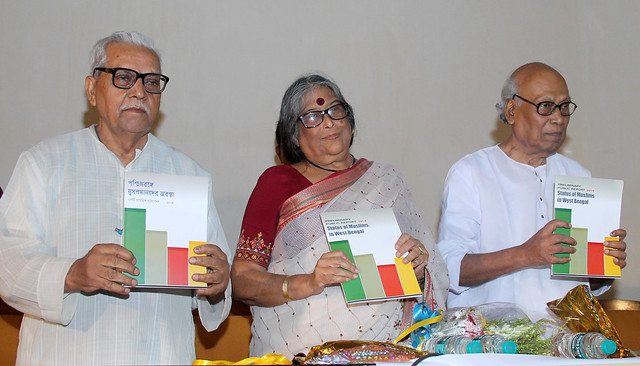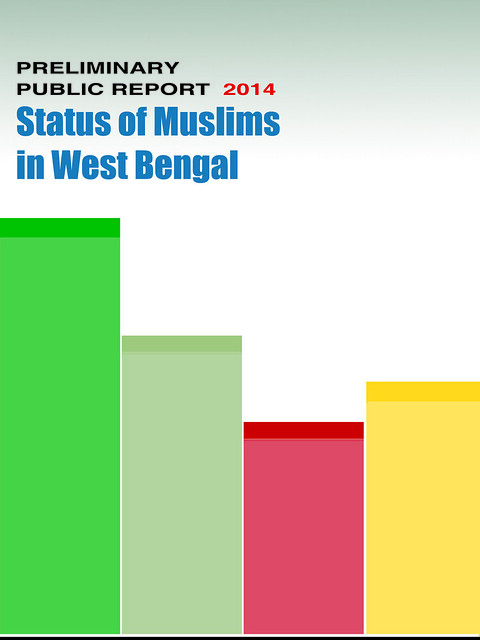By Zaidul Haque, TwoCircles.net,
Kolkata: Seven years after the Sachar Committee Report, there is no marked change in the socio-economic conditions of Muslims in West Bengal, a new “Public Report on the Status of Muslims in West Bengal” note.
To assess the socio-economic and educational conditions of Muslims in West Bengal, a preliminary study was conducted jointly by NGO Social Network for Assistance to People (SNAP) and Guidance Guild. The ‘public report’ was released on 31 May at Indian Science Congress Association Hall, Kolkata.

Release of report on “Status of Muslim in West Bengal” in Kolkata on 31 May, 2014 by Hazi Md Khalil, Writer Nabanita Deb Sen, Poet Shankha Ghosh.
Secretary of Guidance Guild and renowned social activist Hazi Muhammad Khalil, eminent writer Nabanita Deb Sen and Poet Shankha Ghosh inaugurated the preliminary survey report `Status of Muslims in West Bengal, Preliminary Public report 2014’.
The 77 page report puts light on the continuing poor conditions of Muslims of West Bengal. The report highlights some important socio-economic issues, concerning Muslims of West Bengal, even seven years after the landmark all-Indian study done by central government appointed Sachar Committee. It points out that there is no marked change in the conditions of Muslims in the state.
After released of Survey report poet Shankha Ghosh said, “When any Muslim comes to my home, then others guest always ask him, if he has come from Bangladesh, which is unfortunate. We have to remove this misconception.”
Writer Nabanita Deb Sen pointed that most of the schemes for meant for Muslims are only paper and for real change to come, we have to implement these indiscriminately.
Achintya Chakraborty pointed that last three-four years there have been some positive changes in the situations of Muslims in the state and sounded optimistic that gradually thiings will improve.
SNAP secretary, IIT Scholar Jahangir Hossain, Politician Abdur Rajjak Molla, Maulana Siddiqullah Chowdhury, Data expert Amirul Alam, Educationalist Miratun Nahar, Proffessor Sirajul Islam, Milan Dutta, Manisha Banerjee and many others personalities were also present in the programme.
The Honorary Chief PRO of SNAP Amirul Alam said that they have conducted the study in the state without any government support to maintain the impartiality on the report. He pointed out that on the initiatives of community organisations, the work on the survey began way back in October 2011 and was completed in May, this year. 163 enumerators (Male – 70% & Female – 30%), were thus involved for a total of 2 years 6 months in this project.
The survey was carried out in 325 villages and 73 urban wards, in the first phase of the inquiry, to cover 97017 (79913 rural and 17104 urban) households and in second phase another 8000 households were included.
Amirul Alam pointed out that they also sought the help of Noble Laureate Amrtya Sen’s Organisation `Pratichi Trust’ and those valuable inputs by likes of Dr Amartya Sen, Dr Manabi Mazumdar, Dr Achintya Chakraborty were taken.
The study group was headed by Dr P. P. Ghosh, Director of Asian Development Research Institute (ADRI) of Patna.
Although then Left front Government had initially refused to accept the findings of the Sachar Report, they and later the TMC government subsequently tried to improve the situations. The preliminary report, however, suggests little improvement.
The present analysis of the collected data on select indicators throws light on some important dimensions of the lives and livelihoods of Muslims of West Bengal. Unlike the all India scenario, proportion of Muslims living in rural areas is very high. For a large majority of the Muslims of West Bengal manual and menial work is the only option of livelihood.

Summary of Preliminary Survey report
Living Areas: Most of the Muslims of West Bengal live in village. 83 percent Muslims are living in Village area and only 17 percent in urban areas.
Earning Way: Most of the Muslims earn their living through menial labour work.
Education: The educational status of the Muslims shows a dismal picture: no literate adult was found in nearly one fifth of the surveyed households and this is certainly a cause for concern. Even large proportion of those who had had the opportunity of becoming literate or going to school could pursue their studies only up to primary level.
As evident from the school enrolment data, there appeared a substantial gap between growing aspirations among Muslims towards acquiring modern public education and the actual provision to realise such social ambitions. That the rate of enrolment in schools was very high in the areas with Muslim preponderance clearly showed that, not only they were not averse to modern education but also that there was a clear lack of educational infrastructure in those areas.
Health Sector: The health sector was also found to be suffering from similar, glaring dearth of facilities: while there was no proof of Muslim’s not accepting the modern health facilities, the field level data clearly showed that areas inhabited by Muslims were quite poorly equipped with such provisions.
Condition of Road: A major disadvantage that people of the surveyed hamlets appeared to have faced was the poor condition of roads. In 27 percent of the total cases, roads inside the hamlet were reported to be waterlogged; and another 18 per cent had kuccha roads not suitable even for bicycle riding. Only 9 percent of the roads were pucca and a meagre 4 percent were made of concrete. Again, paras inhabited predominantly by the adivasis, dalits and Muslims had a much larger share of waterlogged roads than what an upper caste hamlet had.
Electricity: Despite the centrality of the supply of electricity in the modern world nearly 8 percent of the selected hamlets were found to be deprived of this basic facility.
Drinking Water: 94 percent of the villages were found to have publicly provided tube wells; their functionality was much below the threshold of satisfaction. Government supplied tap water was available in only 36 percent of the villages, but, it too was not sufficient to serve the whole population.
Health Facilities: The Primary Health Centre is the lowest unit where some of the basic services, like dispensary, child delivery facility, etc, are supposed to be available. As the survey found, 35 percent of the villagers had to commute at least four kilometres to access this facility, and in 12 percent of the cases the distance was even longer – more than 8 Kilometres. It is often argued that Muslims are averse to modern health facilities. But, given the poor accessibility of the modern health facilities on one hand and our observation on the other of the willingness of the members of this community to utilise modern health facilities of decent quality wherever available, this perception appears to be quite unfounded.

Audience of the Status of Muslim in West Bengal report release programme at Indian Science Congress Association Auditorium Hall, Park Circus on 31st May, 2014. (pix: Khalidur Rahim)
Educational Institution: In the survey areas numbers of private schools and private Madrashas were found to be 30 and 22 respectively against a total of 774 government run institutions. However, in nearly 3 percent of the villages, which had more than 1000 population, there was no educational institution at all. In short, public provisioning of educational infrastructures and resources, and the quality thereof, appeared critical for the educational progress of this community.
Other Basic Facilities: It has been observed that 10 percent villages did not have any ICDS centre, which is regarded as a prime important institution for child development. While these 10 percent villages are directly deprived of the facility, the poor functioning of the ICDS centers in many other villages are kept them as mere showcases. 27 per cent of the surveyed villages were found to be flood-prone, while another 21 percent reported to be regularly hit by drought. In only 7 percent of the total flood affected villages people reported to have received government assistance whereas 70 percent villages were provided with government assistance on pick and choose basis (only for a few people) and 23 percent villages were rendered nothing . Similarly only 4 percent of draught affected villages had received some help from Government.
The preliminary report suggests that above all there is a capability deprivation – the lack of opportunity for self-emancipation – that is responsible for the poor socio-economic conditions of Muslims.
Full report “Public Report on the Status of Muslims in West Bengal” — (In Bangla)

